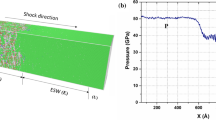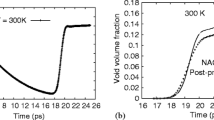Abstract
Molecular dynamics simulations were performed to study the evolution of void along different crystallographic orientations of single-crystal copper under shock compression, including \([1\overline{{{\kern 1pt} 1{\kern 1pt} }} 0]\), \([111]\) and \([100]\) orientations. For both \([1\overline{{{\kern 1pt} 1{\kern 1pt} }} 0]\) and \([111]\) directions, the void only shrinks and does not collapse, whereas for \([100]\) direction, the void can gradually shrink until it collapses completely. Dislocations react with each other to form sessile dislocations during the continuous loading of the shock waves, in both \([1\overline{{{\kern 1pt} 1{\kern 1pt} }} 0]\) and [111] directions, and almost all the dislocations are found to be \(\frac{a}{6} < 110 >\) stair-rod partial dislocations which are of sessile type. However, for the [100] orientation, sessile dislocations are mainly \(\frac{a}{3} < 001 >\) Hirth partial dislocations. For \([100]\) direction, the sessile dislocation density is the lowest among the three orientations. Therefore, shock compression along \([100]\) direction is more conducive to plastic deformation of the void. Dislocation slip is responsible for deformation mechanism of the void, where \(\frac{a}{6} < 112 >\) Shockley partial dislocations are firstly generated on the surface of the void, and then they continue to move and multiply, which shall lay the foundation for the formation of stacking faults. Stacking faults sweep through the crystal plane and consequently the void shrinks. This work gives an atomic-scale observation perspective of the evolution of micro-void defects in single-crystal copper under shock compression and provides a clearer explanation for the understanding of the dislocation evolution mechanism behind the deformation.












Similar content being viewed by others
Data Availability
The data that support the findings of this study are available within the article. Further requests can be made to the corresponding author.
References
C.F. Tipper, The Fracture of Metals, Metallurgia, 1949, 39, p 133–137.
H.C. Rogers, The Tensile Fracture of Ductile Metals, Trans. Met. Soc. AIME, 1960, 218, p 498–506.
T.W. Barbee Jr., L. Seaman, R.C. Crewdson and D.R. Curran, Dynamic Fracture Criteria for Ductile and Brittle Metals, J. Mater., 1972, 7, p 393–401.
L. Seaman, D.R. Curran and D.A. Shockey, Computational Models for Ductile and Brittle Fracture, J. Appl. Phys., 1976, 47(11), p 4814–4826.
D.R. Curran, L. Seaman and D.A. Shockey, Dynamic Failure in Solids, Phys. Today, 1977, 30(1), p 46–55.
C. Hong, S. Fæster, N. Hansen, X. Huang and R.I. Barabash, Non-Spherical Voids and Lattice Reorientation Patterning in a Shock-Loaded Al Single Crystal, Acta Mater., 2017, 134, p 16–30.
Ma. Dongfang, Wu. Chen Danian, W.H. Shanxing, C. Canyuan and D. Gaotao, Dynamic Experimental Verification of Void Coalescence Criteria, Mater. Sci. Eng. A., 2012, 533, p 96–106.
B.C. Hornbuckle, S.W. Dean, X. Zhou, A.K. Giri, C.L. Williams, K.N. Solanki, G.B. Thompson and K.A. Darling, Laser Shocking of Nanocrystalline Materials: Revealing the Extreme Pressure Effects on the Microstructural Stability and Deformation Response, Appl. Phys. Lett., 2020, 116, p 231901.
V.A. Lubarda, M.S. Schneider, D.H. Kalantar, B.A. Remington and M.A. Meyers, Void Growth by Dislocation Emission, Acta Mater., 2024, 52, p 1397–1408.
M.S. Schneider, B. Kad, D.H. Kalantar, B.A. Remington, E. Kenik, H. Jarmakani and M.A. Meyers, Laser Shock Compression of Copper and Copper–Aluminum Alloys, Int. J. Impact Eng., 2005, 32, p 473–507.
J.C. Crowhurst, M.R. Armstrong, S.D. Gates, J.M. Zaug, H.B. Radousky and N.E. Teslich, Yielding of Tantalum at Strain Rates up to 109 s-1, Appl. Phys. Lett., 2016, 109, p 094102.
Y. Wang, H. He and L. Wang, Critical Damage Evolution Model for Spall Failure of Ductile Metals, Mech. Mater., 2013, 56, p 131–141.
J.W. Wilkerson, On the Micromechanics of Void Dynamics at Extreme Rates, Int. J. Plast., 2017, 95, p 21–42.
M. Ponga, M. Ortiz and M.P. Ariz, Finite-Temperature Non-Equilibrium Quasi-Continuum Analysis of Nanovoid Growth in Copper at Low and High Strain Rates, Mech. Mater., 2015, 90, p 253–267.
U. Asim, M.A. Siddiq and M. Demiral, Void Growth in High Strength Aluminium Alloy Single Crystals: a CPFEM Based Study, Model. Simul. Mater. Sci. Eng., 2017, 25, p 035010.
Z.G. Liu, W.H. Wong and T.F. Guo, Void Behaviors from Low to High Triaxialities: Transition from Void Collapse to Void Coalescence, Int. J. Plast., 2016, 84, p 183–202.
X.D. Ren, W.F. Zhou, Y.P. Ren, S.D. Xu, F.F. Liu, S.Q. Yuan, N.F. Ren and J.J. Huang, Dislocation Evolution and Properties Enhancement of GH2036 by Laser Shock Processing: Dislocation Dynamics Simulation and Experiment, Mater. Sci. Eng. A., 2016, 654, p 184–192.
Y. Liao and G.J. Cheng, Controlled Precipitation by Thermal Engineered Laser Shock Peening and its Effect on Dislocation Pinning: Multiscale Dislocation Dynamics Simulation and Experiments, Acta Mater., 2013, 61, p 1957–1967.
G. Li, Y. Wang, M. Xiang, Yi. Liao, K. Wang and J. Chen, Shock Response of Nanoporous Magnesium by Molecular Dynamics Simulations, Int. J. Mech. Sci., 2018, 141, p 143–156.
J.F. Tang, J.C. Xiao, L. Deng, W. Li, X.M. Zhang and L. Wang, Shock Wave Propagation, Plasticity, and Void Collapse in Open-Cell Nanoporous Ta, Phys. Chem. Chem. Phys., 2018, 20, p 28039–28048.
S. Rawat and P.M. Raole, Molecular Dynamics Investigation of Void Evolution Dynamics in Single Crystal Iron at Extreme Strain Rates, Comput. Mater. Sci., 2018, 154, p 393–404.
V.A. Lubarda, M.S. Schneider, D.H. Kalantar, B.A. Remington and M.A. Meyers, Void Growth by Dislocation Emission, Acta Mater., 2004, 52, p 1397–1408.
L.P. Dávila, P. Erhart, E.M. Bringa, M.A. Meyers, V.A. Lubarda, M.S. Schneider, R. Becker and M. Kumar, Atomistic Modeling of Shock-Induced Void Collapse in Copper, Appl. Phys. Lett., 2005, 86, p 161902.
W. Zhu, Z. Song, X. Deng, H. He and X. Cheng, Lattice Orientation Effect on the Nanovoid Growth in Copper Under Shock Loading, Phys. Rev. B., 2007, 75, p 024104.
T.-T. Zhou, A.-M. He, P. Wang and J.-L. Shao, Spall Damage in Single Crystal Al with Helium Bubbles Under Decaying Shock Loading Via Molecular Dynamics Study, Comput. Mater. Sci., 2019, 162, p 255–267.
X. Deng, W. Zhu, Y. Zhang, H. He and F. Jing, Configuration Effect on Coalescence of Voids in Single-Crystal Copper Under Shock Loading, Comput. Mater. Sci., 2010, 50, p 234–238.
X. Peng, W. Zhu, K. Chen, X. Deng and Y. Wei, Molecular Dynamics Simulations of Void Coalescence in Monocrystalline Copper Under Loading and Unloading, Modell. J. Appl. Phys., 2016, 119, p 165901.
K. Mackenchery, R.R. Valisetty, R.R. Namburu, A. Stukowski, A.M. Rajendran and A.M. Dongare, Dislocation Evolution and Peak Spall Strengths in Single Crystal and Nanocrystalline Cu, J. Appl. Phys., 2016, 119, p 044301.
G. Agarwal and A.M. Dongare, Defect and damage Evolution During Spallation of Single Crystal Al: Comparison Between Molecular Dynamics and Quasi-Coarse-Grained Dynamics Simulations, Comput. Mater. Sci., 2018, 145, p 68–79.
S. Galitskiy, D.S. Ivanov and A.M. Dongare, Dynamic Evolution of Microstructure During Laser Shock Loading and Spall Failure of Single Crystal Al at the Atomic Scales, Phys. J. Appl. Phys., 2018, 124, p 205901.
M. Xiang, J. Cui, Y. Yang, Yi. Liao, K. Wang, Y. Chen and J. Chen, Shock Responses of Nanoporous Aluminum by Molecular Dynamics Simulations, Int. J. Plast., 2017, 97, p 24–45.
Yi. Liao, M. Xiang, G. Li, K. Wang, X. Zhang and J. Chen, Molecular Dynamics Studies on Energy Dissipation and Void Collapse in Graded Nanoporous Nickel Under Shock Compression, Mech. Mater., 2018, 126, p 13–25.
K.V. Reddy and S. Pal, Shock Velocity-Dependent Elastic-Plastic Collapse of Pre-Existing Stacking Fault Tetrahedron in Single Crystal Cu, Comput. Mater. Sci., 2020, 172, p 109390.
P. Hirel and Atomsk: A Tool for Manipulating and Converting Atomic Data Files, Comput. Phys. Comm., 2015, 197, p 212–219.
S. Plimpton and F. Parallel, Fast Parallel Algorithms for Short-Range Molecular Dynamics, J. Comp. Phys., 1995, 117, p 1–19.
X.W. Zhou, R.A. Johnson and H.N.G. Wadley, Misfit-Energy-Increasing Dislocations in Vapor-Deposited CoFe/NiFe Multilayers, Phys. Rev. B., 2004, 69, p 144113.
P.N. Mayer and A.E. Mayer, Size Distribution of Pores in Metal Melts at Non-Equilibrium Cavitation and Further Stretching, and Similarity with the Spall Fracture of Solids, Int. J. Heat Mass Transf., 2018, 127, p 643–657.
G.C. Ma, J.L. Fan and H.R. Gong, Mechanical Behavior of Cu-W Interface Systems Upon Tensile Loading from Molecular Dynamics Simulations, Comput. Mater. Sci., 2018, 152, p 165–168.
T. Zhang, K. Zhou and Z.Q. Chen, Strain Rate Effect on Plastic Deformation of Nanocrystalline Copper Investigated by Molecular Dynamics, Mater. Sci. Eng. A., 2015, 648, p 23–30.
K. Zhou, B. Liu, YiJun Yao and K. Zhong, Grain Coarsening in Nanocrystalline Copper with Very Small Grain Size During Tensile Deformation, Mater. Sci. Eng. A., 2014, 595, p 118–123.
M. Yuasa, T. Nakazawa and M. Mabuchi, Atomic Simulations of Dislocation Emission from Cu/Cu and Co/Cu Grain Boundaries, Mater. Sci. Eng. A., 2010, 528, p 260–267.
X.W. Zhou, H.N.G. Wadley, R.A. Johson, D.J. Larson, N. Tabat, A. Cerezo, A.K. Petford-Long, G.D.W. Smith, P.H. Clifton, R.L. Matrens and T.F. Kelly, Atomic Scale Structure of Sputtered Metal Multilayers, Acta mater., 2001, 49, p 4005–4015.
A. Stukowski, Visualization and Analysis of Atomistic Simulation Data with OVITO-the Open Visualization Tool, Modell. Simul. Mater. Sci. Eng., 2010, 18(1), p 015012.
A. Stukowski, Structure Identification Methods for Atomistic Simulations of Crystalline Materials, Model. Simul. Mater. Sci. Eng., 2012, 20, p 045021.
C.L. Kelchner, S.J. Plimpton and J.C. Hamilton, Dislocation Nucleation and Defect Structure During Surface Indentation, Phys. Rev. B., 1998, 58(17), p 11085–11088.
A. Stukowski, V.V. Bulatov and A. Arsenlis, Automated Identification and Indexing of Dislocations in Crystal Interfaces, Model. Simul. Mater. Sci. Eng., 2012, 20, p 085007.
F. Tang, Z. Jian, S. Xiao, X. Li, L. Wang, B. Huang, H. Deng and Hu. Wangyu, Molecular Dynamics Simulation of Cylindrically Converging Shock Response in Single Crystal Cu, Comput. Mater. Sci., 2020, 183, p 10984.
F.T. Latypov, A.E. Mayer and V.S. Krasnikov, Dynamics of Growth and Collapse of Nanopores in Copper, INT J. Solids Struct., 2020, 202, p 418–433.
E.M. Bringa, S. Traiviratana and M.A. Meyers, Void Initiation in fcc Metals: Effect of Loading Orientation and Nanocrystalline Effects, Acta Mater., 2010, 58, p 4458–4477.
C. Qiao, Y. Guo, Z. Wang, Y. Zheng, R. Zhang, L. Chen, Y.-L. Chen, Su. Wan-Sheng, Yu. Jia and S. Wang, Effect of Body Defect on Mechanical Behaviors of Cu Nanowire Under Tension: A Molecular Dynamics Investigation, J. Mater. Sci., 2017, 52, p 13237–13246.
Acknowledgments
This work was supported by the National Natural Science Foundation of China (No. 51871070).
Author information
Authors and Affiliations
Corresponding authors
Ethics declarations
Conflict of interest
The authors declare that they have no known competing financial interests or personal relationships that could have appeared to influence the work reported in this paper.
Additional information
Publisher's Note
Springer Nature remains neutral with regard to jurisdictional claims in published maps and institutional affiliations.
Rights and permissions
About this article
Cite this article
Wang, M., Zhang, Y. & Jiang, S. Atomic Simulation of Crystallographic Orientation Effect on Void Shrinkage and Collapse in Single-Crystal Copper under Shock Compression. J. of Materi Eng and Perform 31, 2991–3003 (2022). https://doi.org/10.1007/s11665-021-06438-0
Received:
Revised:
Accepted:
Published:
Issue Date:
DOI: https://doi.org/10.1007/s11665-021-06438-0




